Of course I couldn´t leave the Hanse shipyard without checking out one of the their boats on display as it would have been a waste of opportunity. As you may have read in the previous post when I visited the production site of Hanse Yachts in Greifswald they´ve built a large showroom at the entrance to the yard that is used by the sales department and their dealers to showcase the current fleet and welcome potential boat buyers. I asked Vice President Maxim Neumann if I could also get a little tour inside and he agreed.
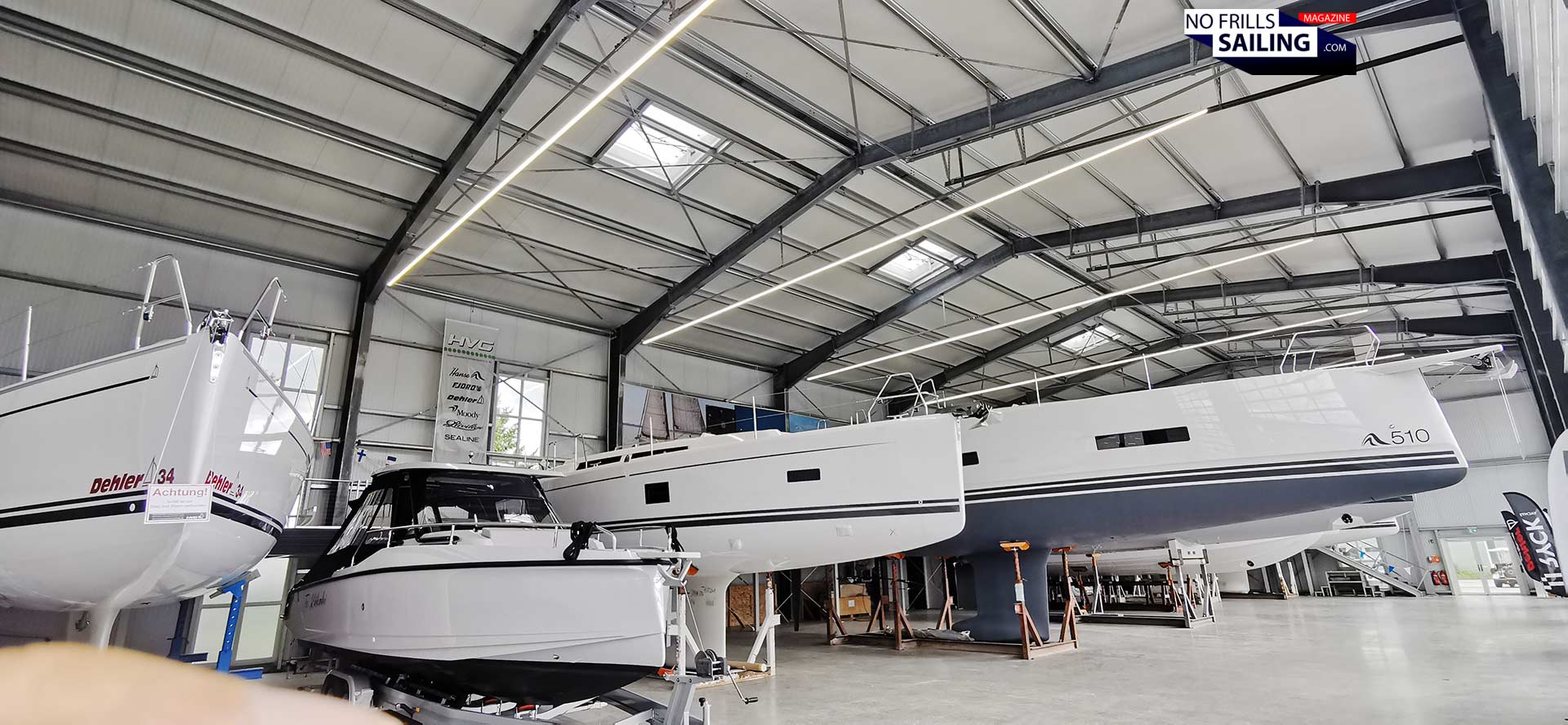
Many boats had been on display, a nice mixture of Hanse Yachts´ palette of brands which, many don´t know this, is quite impressive. Their strongest and eponymous brand is of course the sailing cruiser Hanse. But there is more: Dehler Yachts, classic performance yachts from 34 to 46 feet and their take at racing one-design, the Dehler 30 OD is an offer to the more sailing-oriented owners whereas Moody offers an upper priced deck saloon yacht for the perfect vacation and big sailing cruiser on the other end of the sailing spectrum. Apart from sailing yachts, Hanse Yachts AG manufactures power boats, namely Fjord, Sealine and, their latest acquisition, Ryck boats. Of the boats on display, the large Hanse 510 was the one of most interest for me, so let´s start our walkthrough.
Why a “European Cruiser”?
You may have raised your eyebrows reading the title. Why did I choose to dub this boat a “European Cruiser”? Well, the 510 to me is indeed another testament to my first impression some years ago when I saw the – then – brand new Hanse 460 and read the headline about the collaboration of the shipyard with the renowned French naval architects of Berret-Racoupeau. I literally applauded them to this bold decision. Skipping Judel/Vrolijk as their principle designers must have been a huge step (with all the trouble I can imagine surrounding such a take) but it opened up a whole new world for the company, in my eyes.
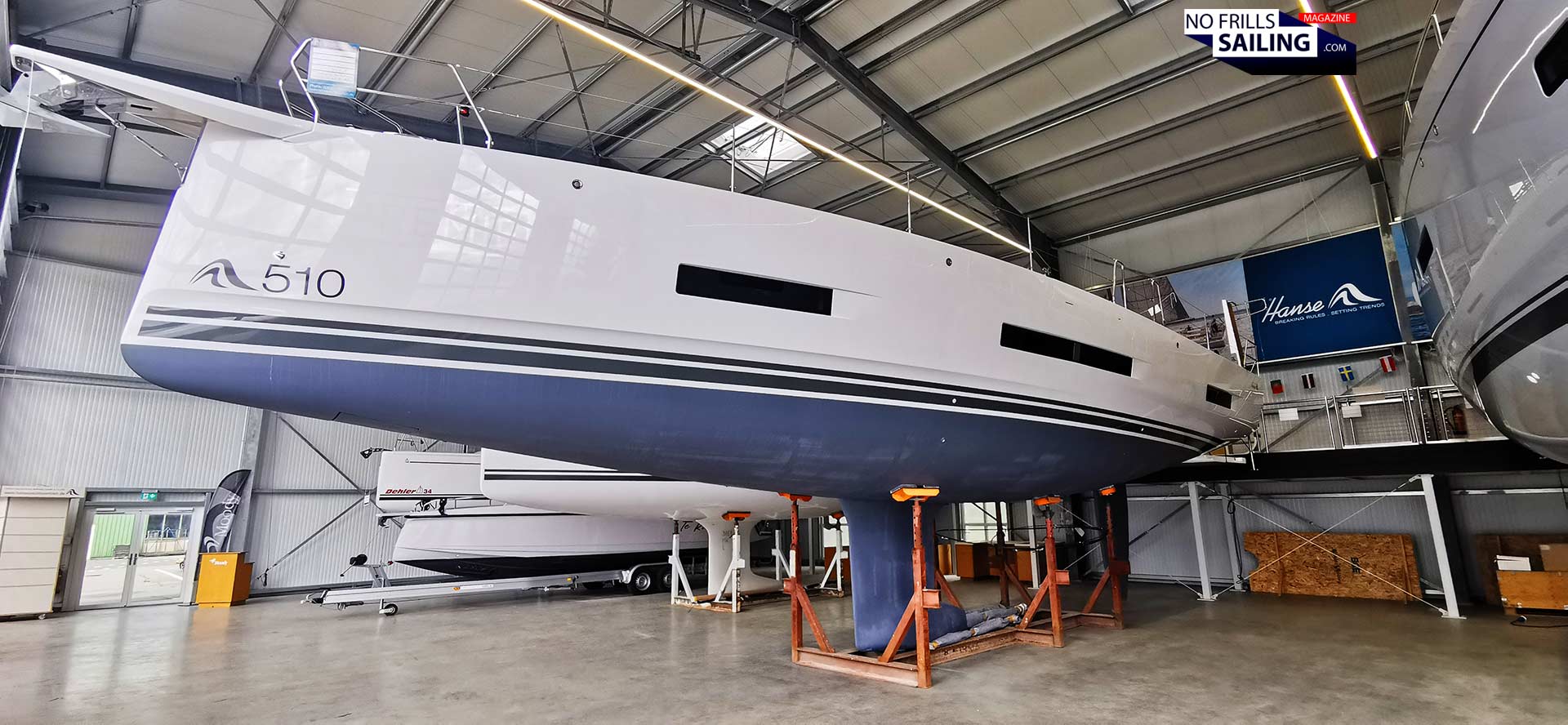
I have nothing against Judel/Vrolijk! They are certainly at the top end among the big names in naval architecture and yacht design, but maybe after so many years Hanse needed a fresh start? And boy, it was fresh! The new 460 back at the time of her launch was a real head turner and even though I got some not so nice response out of my own family, I called their boat the “Paukenschlag”-boat because it kept all the promises – but it also did not make the mistakes so many other brands went on and still go on making. Being too new, too radical and having the break designed too harsh will backfire and scare away your loyal customers. Something, maybe, Bavaria did too aggressively with their new Cossutti-designed boats and which on the other hand had been done nicely by Hallberg-Rassy in the past 8 years or Grand Soleil recently with their new Matteo Polli-designs.

The new Berret-Racoupeau design yachts are a wonderful example of how you modernize your product and come up with something “revolutionary” by not denying or cancelling your roots, hence your previous buyership. The French designers came up with shapes and lines which are really beautiful, aggressive and sportive on the one hand, adhering to Hanse´s brand image – but they also retained a certain “Hanse-like” signature (for example the coachroof windows) so that a new Hanse still looks like a Hanse and that all the owners of an “old” boat aren´t blown away completely and feel out of date with their yachts. The new 510 is no exception, her modern hull shape with a wide stern, negative bow and the three hull windows make her identification easy, but her appearance modern and up-to-date.
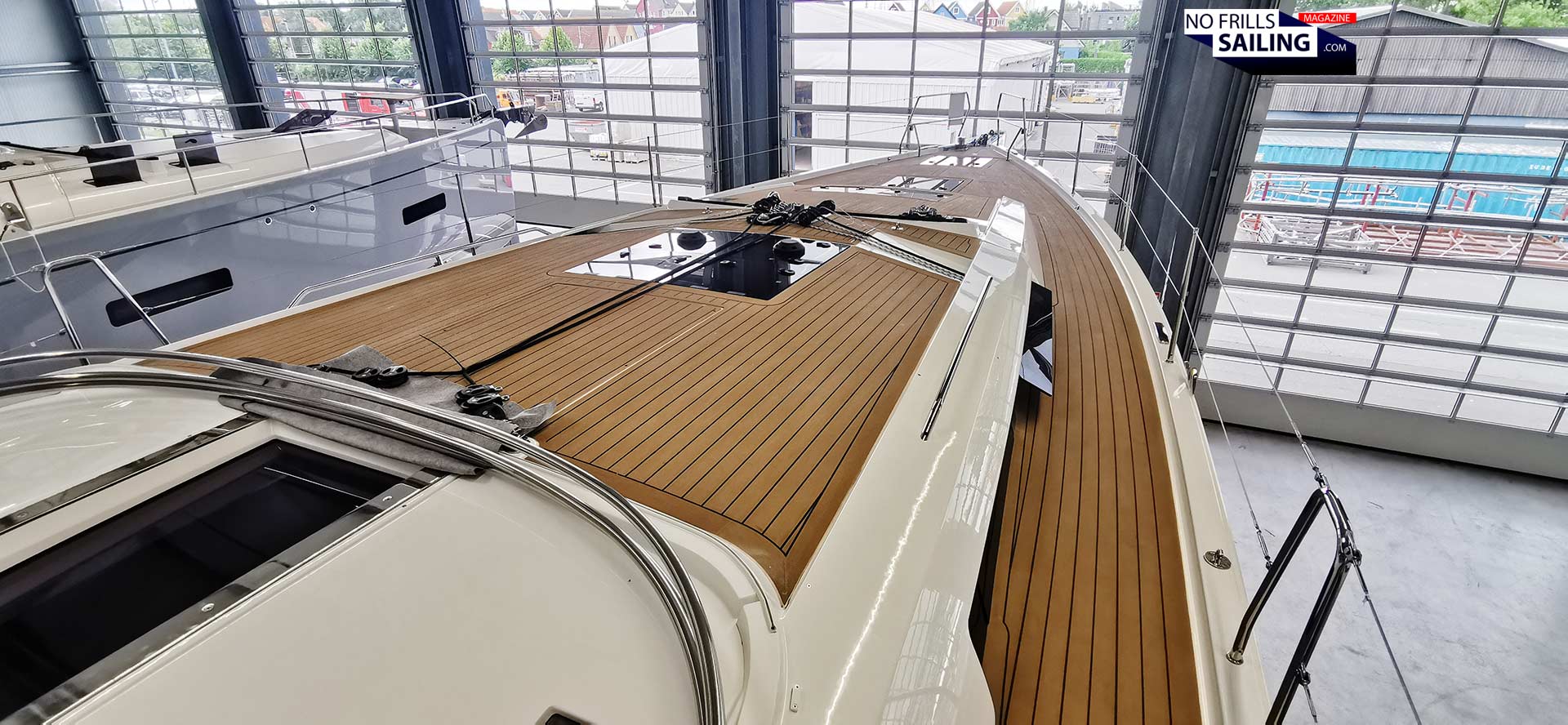
In this, the new 510 (as well as all the other new Berret-Racoupeau designed yachts – is a true European cruiser as she combines the classic values of the German brand with a fresh French approach to sailing. As you know, I am a big fan of French boatbuilders and -designers, I´d say that in the new line-up of Hanse yachts currently available the best of German engineering and especially Hanse´s own philosophy of what a series production boat should be like has been connected and valorized by the French approach on what vocational sailing should be like. A nice German-French joint venture, if you will. So, let´s jump aboard.
The vacation machine
Hanse was invented back in the day to provide sailboats for pleasure and vacation at a reasonable price. That was the intent and idea of then-founder Michael Schmidt (who is now realizing absolute luxury dreams with his Y Yachts-brand, just “around the corner” in Greifswald). In this, of course, the cockpit is the most important location of the boat and focal point of boat life. This yacht has a maximum width of 4.91 meters which is really wide! You can instantly see this large amount of space when standing inside the cockpit.
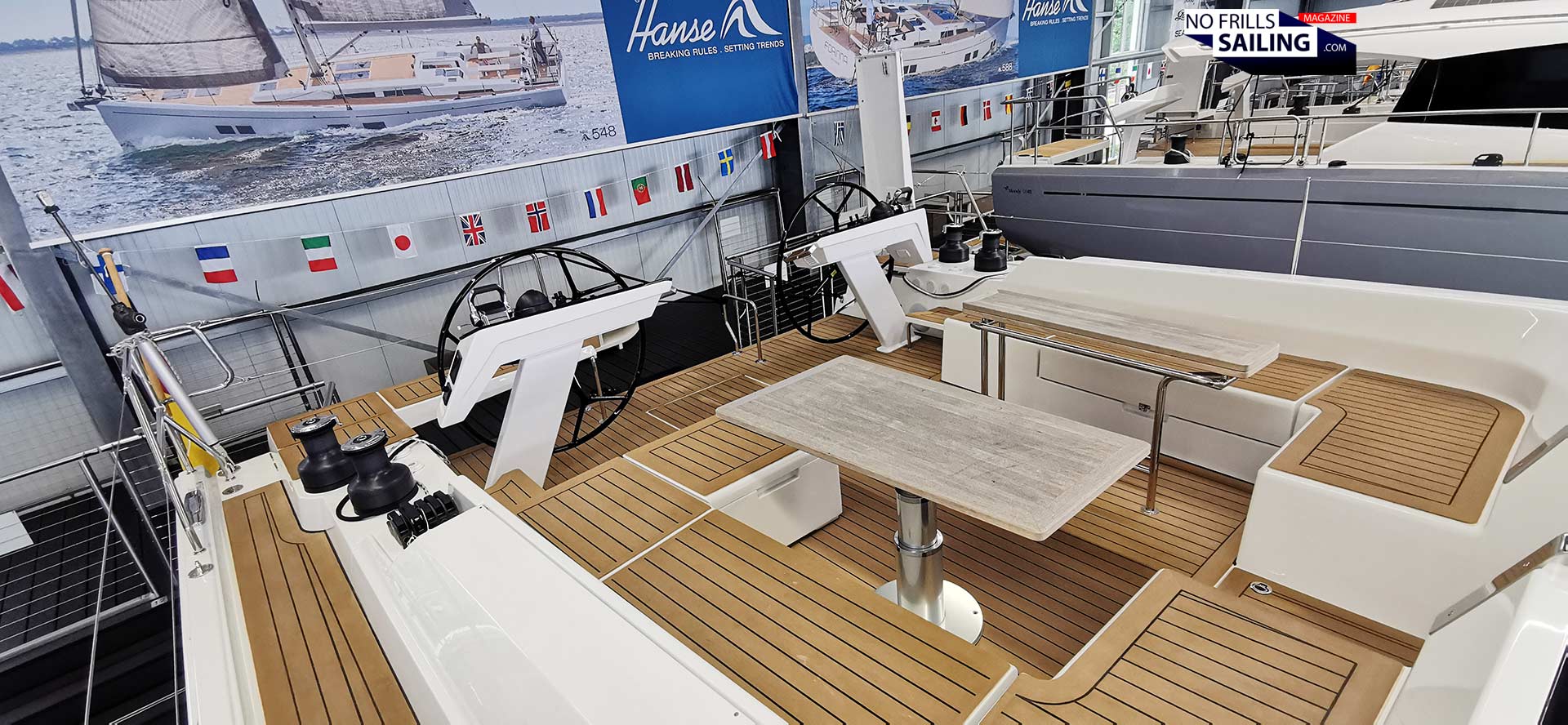
The layout is classy: A free aisle in the middle passing between two cockpit tables and a nice L-shaped configuration of seating benches. The starboard side benches (in the version I visited) had been complemented with a surplus seat to form a U-shape. Together with the (optional) telescopic cockpit table this whole area can be turned into one huge sunbathing lounge – covered with cushions, surely, the place to be when underway with your family!
A sailing machine as well
First and foremost the Hanse 510 is made to sail. She carries A self-tacking Jib or an overlapping Genoa, comes with a classic full batten main (or the inmast furling main) and sports 125 square meters of upwind sails area. For downwind reaching points of sails, she can sport a nice Gennaker and add area up to 272 square meters. For a yacht of some 16.5 tons of displacement not bad: The Oceanis 51.1 has 123 square meters upwind sails area and some 14 tons displacement.
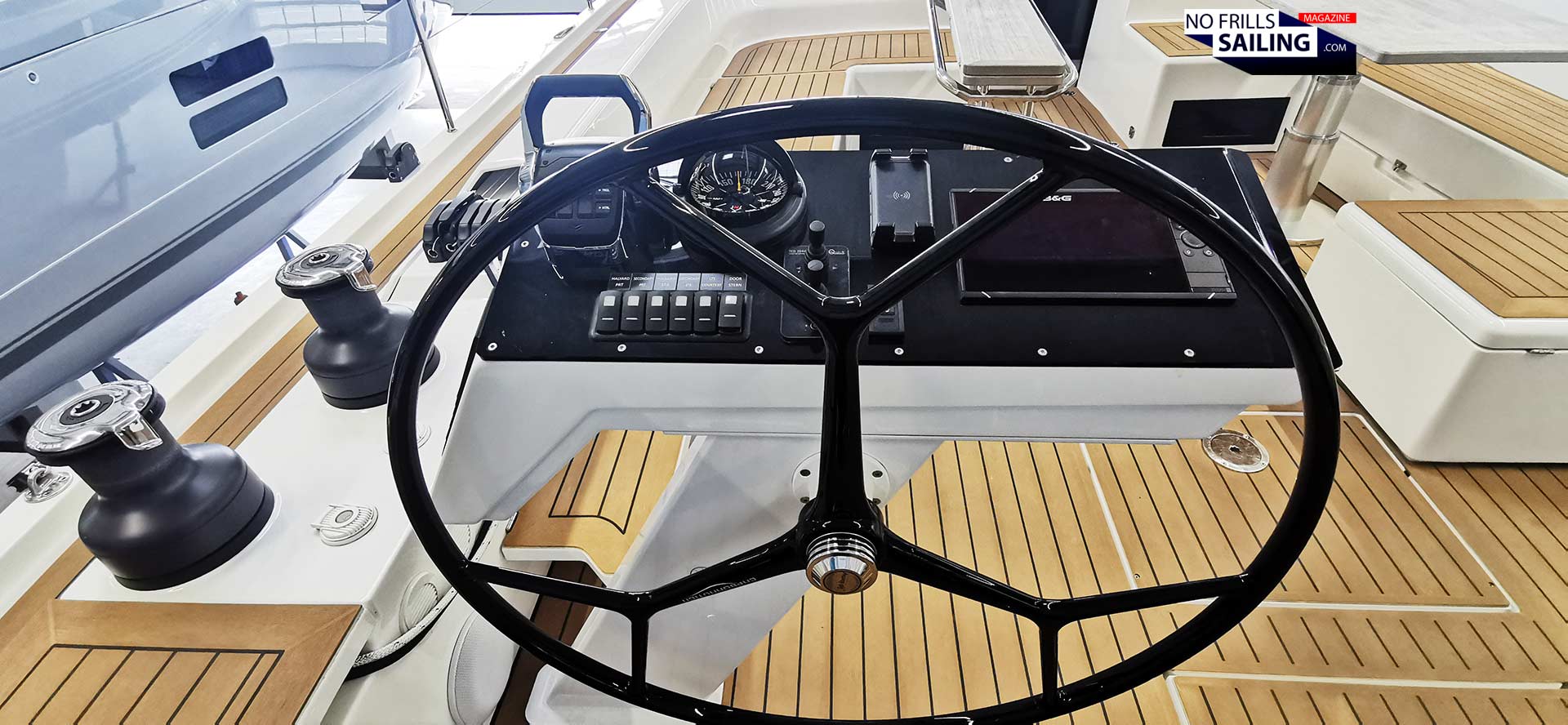
You may have read it in my previous articles about mast and rigging brands, I was always a bit “jealous” looking at Hanse or Bavaria. Why? Because on a Bavaria the masts of Seldén are standard equipment such as Quantum sails are for Hanse Yachts. Looking at the electronic equipment of this Hanse 510 the feeling is the same. At least this boat is fully stacked with board electronics and lots of assistant machinery. Hanse Yachts sticks to B&G as their principle supplier for electronics.

But it is also the layout of the running rigging that is interesting: All winches are located will within reach of the helmsman. Buttons to operate the electric winches, the clamps and even a secondary 4 inch Triton display plus autopilot controls are positioned at the outward sides of the helm-station panels so that you can sit on the side, the coamings, enjoy steering by hand and have the most important data in sight. Nice job!
French-German solutions
There are also little and more “hidden” details which underline the fact that this is not just a facelift or nicely dressed old hat, but a boat that went through many iterations and where a lot of sailors (!) have invested hours and hours of thinking. For example the connectors for the shore power cables:
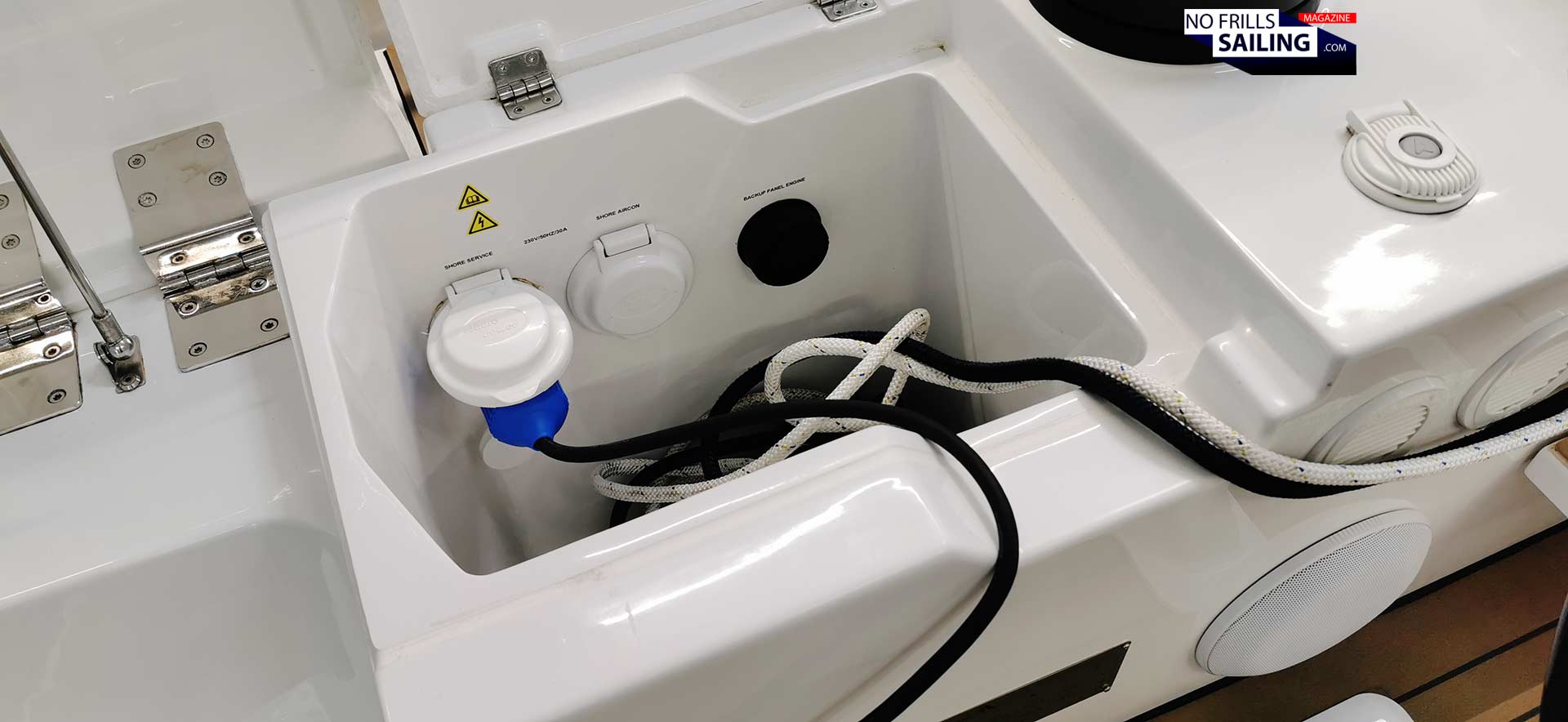
On many boats these plugs (and here we have two: One for 230 V/110 V shore power for the domestic consumers and one for the air conditioning units) are just mounted at the foot of the steering wheel panels or somewhere in this location. The plugs can be closed to be watertight of course but it just looks … well, not so tidy. I always loved the “hidden” plugs on luxury power boats where they just disappear. It´s the same on the Hanse 510: Underneath a little folding seat the dedicated plugs are located (along with the emergency backup throttle for the electronic engine controls). It´s such a nice little thing.
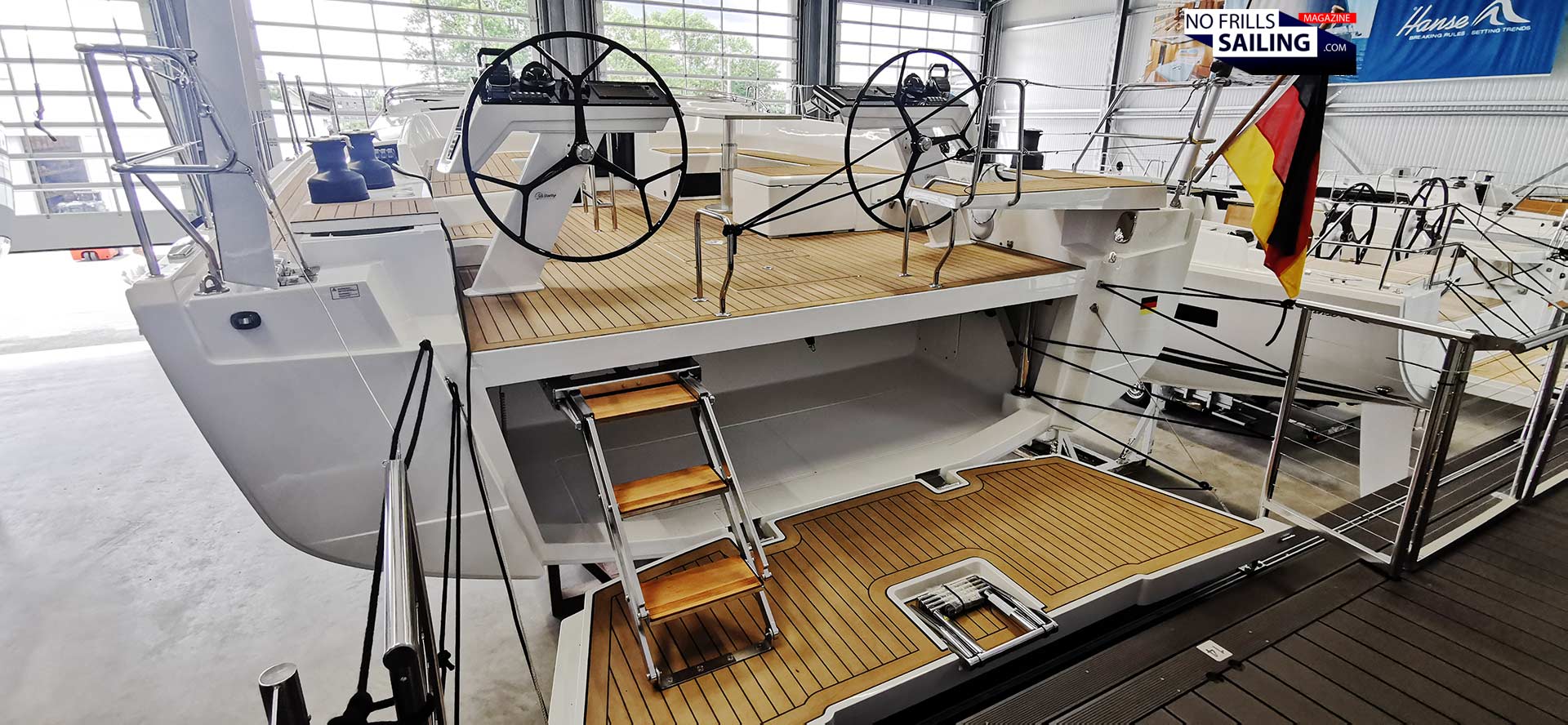
Another nice solution, this time a bit bigger, is the dinghy garage of the Hanse 510. I know a lot of designers who say that a dedicated dinghy garage is only possible to realize in yachts bigger than 55 feet if you don´t want to sacrifice too much internal volume. There are many boats, as “small” as 45-feet, with garages, confirming this: Too small types of dinghies will fit – too much of internal volume is lost. Not so on this yacht: Thanks to a really nice idea. The boat is simply tilted 90 degrees.
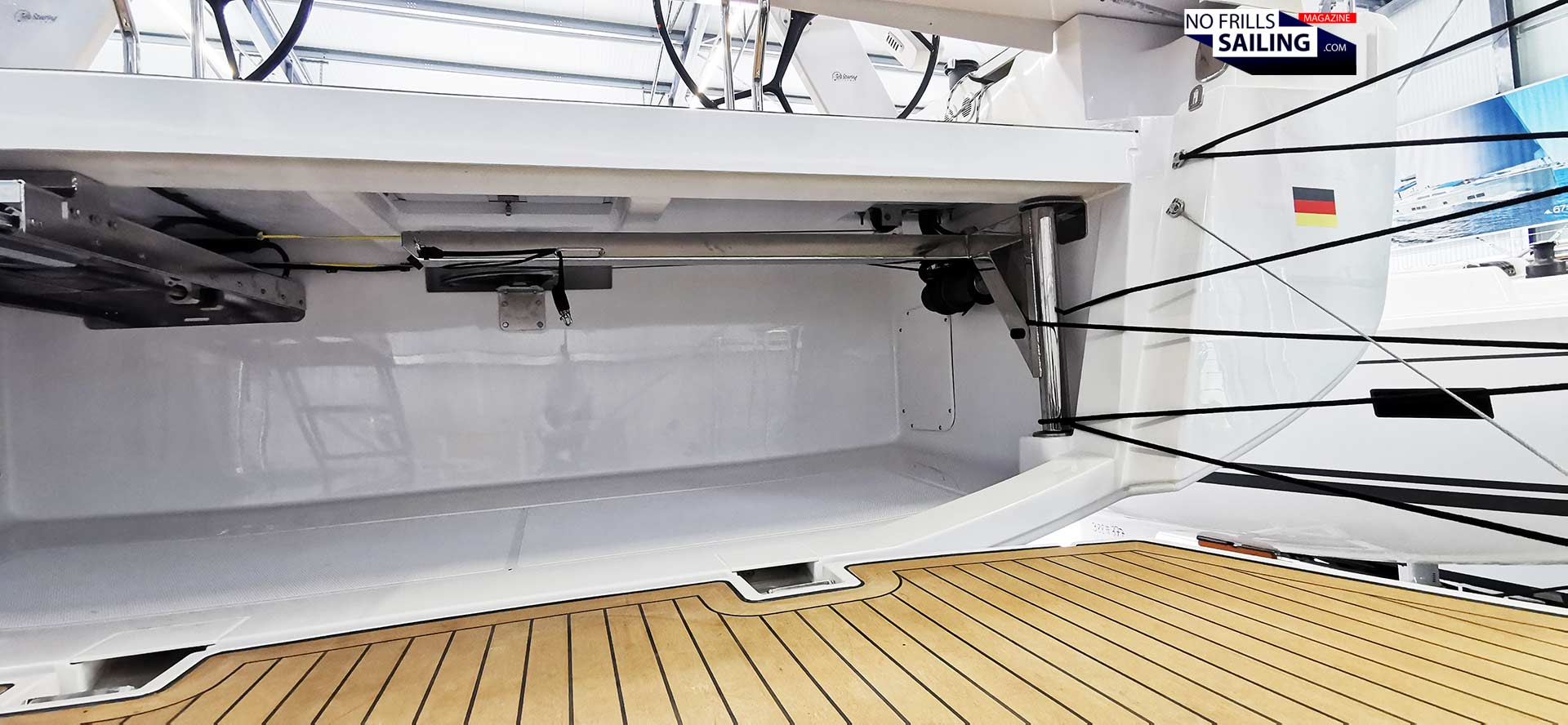
By storing the dinghy crosswise to the yacht´s centerline, the aft cabins (you will see soon) do not loose a single square meter of area nor a single meter of length. And still dinghies up to the size of 2.70 meters can be stored here fully inflated! The tenders will be stored and launched by an ingenious pivoting single davit that if completely hidden within the garage: No more workarounds with telescopic or worse, ugly static davits, no more storing on the bow. The Hanse 510 sports the biggest dinghy garage in her class.
Stylish, rich in contrast
Underneath the boat comes in signature Hanse contrasts, I shall say. This is something you either love or you don´t. Where other brands try to retain a more “retractive” look, offering a clean sheet to be defined by their owners, Hanse always had a very strong idea of interior design, especially when it comes to contrasts. This is visible from your first entry down below: dark and light, black and white or warm and cold. It´s definitely not a boring, homogenous feeling, but “work for your eyes”.
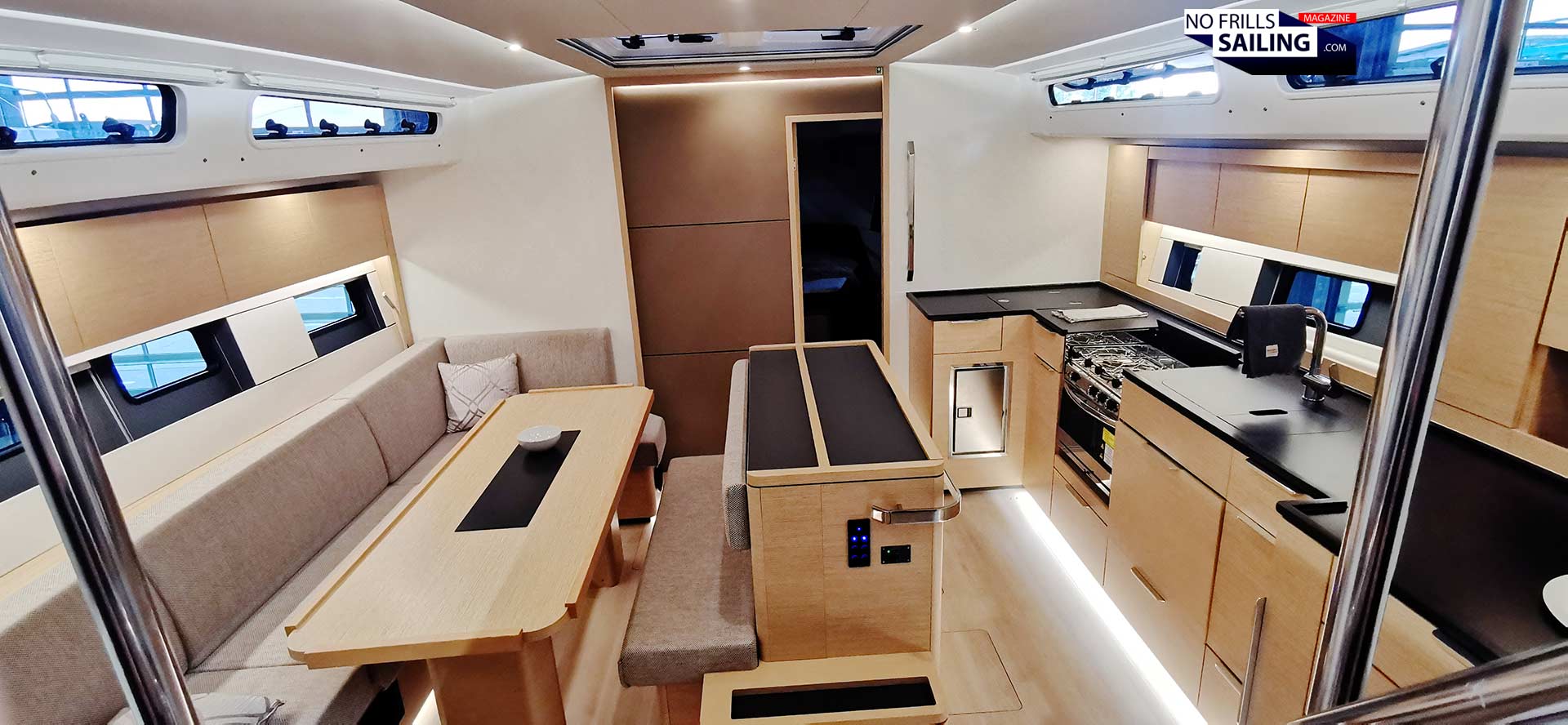
Of course, the options list will make every boat a one of a kind as you may mix the furniture colors with lots of different colors, materials and haptics for the side panels, the floorboards and the cushions. But what I always liked about the Hanse-boats was their stance on interior design: Full of contrasts. Other than that, the 510 has a deciding detail in the saloon that no one can oversee upon walking down the entryway ladder …
A fresh take on chart tables
The – otherwise classically subdivided saloon – is dominated by a central multifunctional piece of joinery. Although it has been made approximately 1/3 slimmer in current models (this boat was hull #1 or #2), it is still there. This central unit divides the saloon into two main areas: Galley and socializing area. The galley-facing (right hand side part of this piece) contains some stowage for food or crockery for the galley.
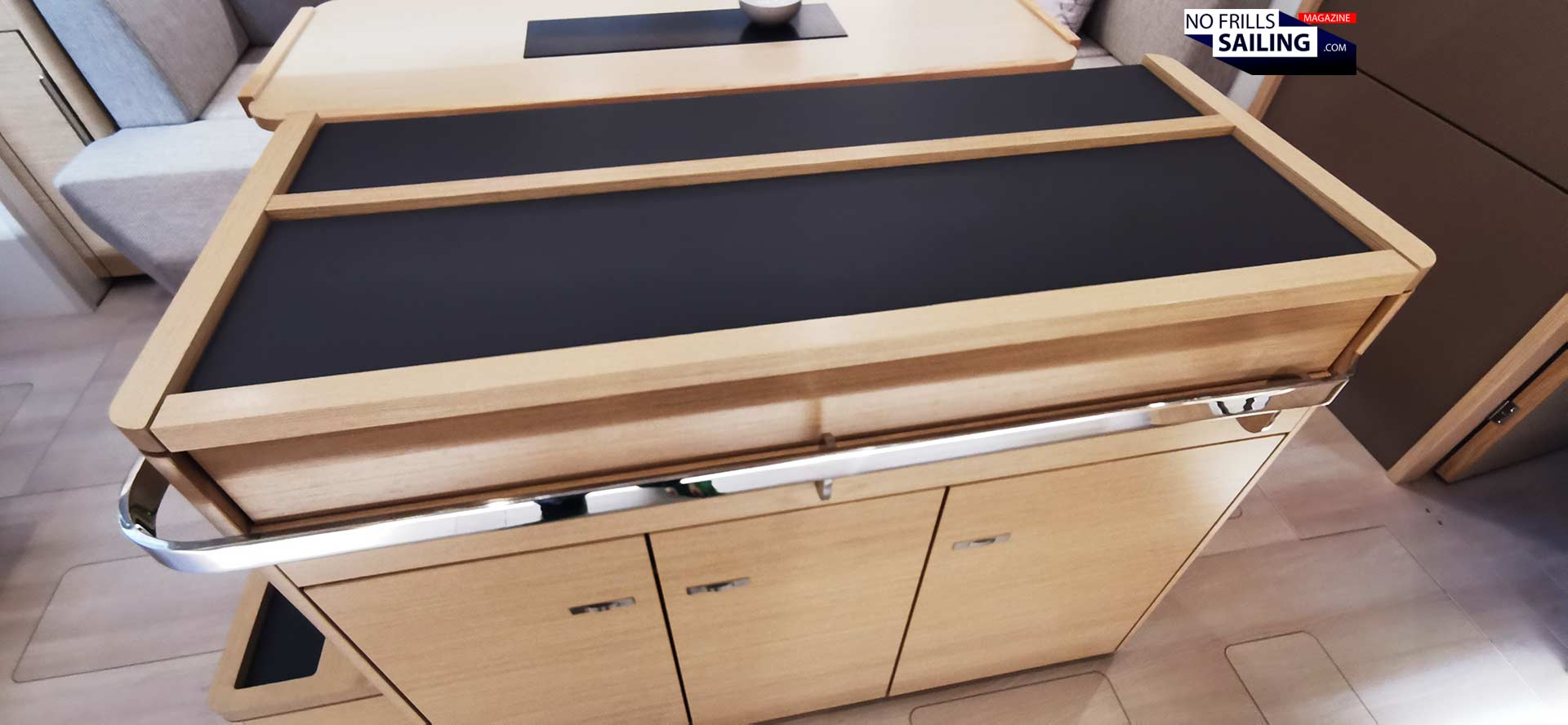
On top it may be used as worktop – maybe if you have a larger party or dinner and you employ some more helpers in the kitchen to chop up veggies, but the most interesting bit is underneath. The cap of this unit can be opened and reveals a full-sized control station for the ship´s electrical systems, main switch panel and parts of the electronics needed at the chart table, like the VHF. At first sight you may think that this is a bit awkward since as Captain you will always have to open the large lid when some action is required, but behold!
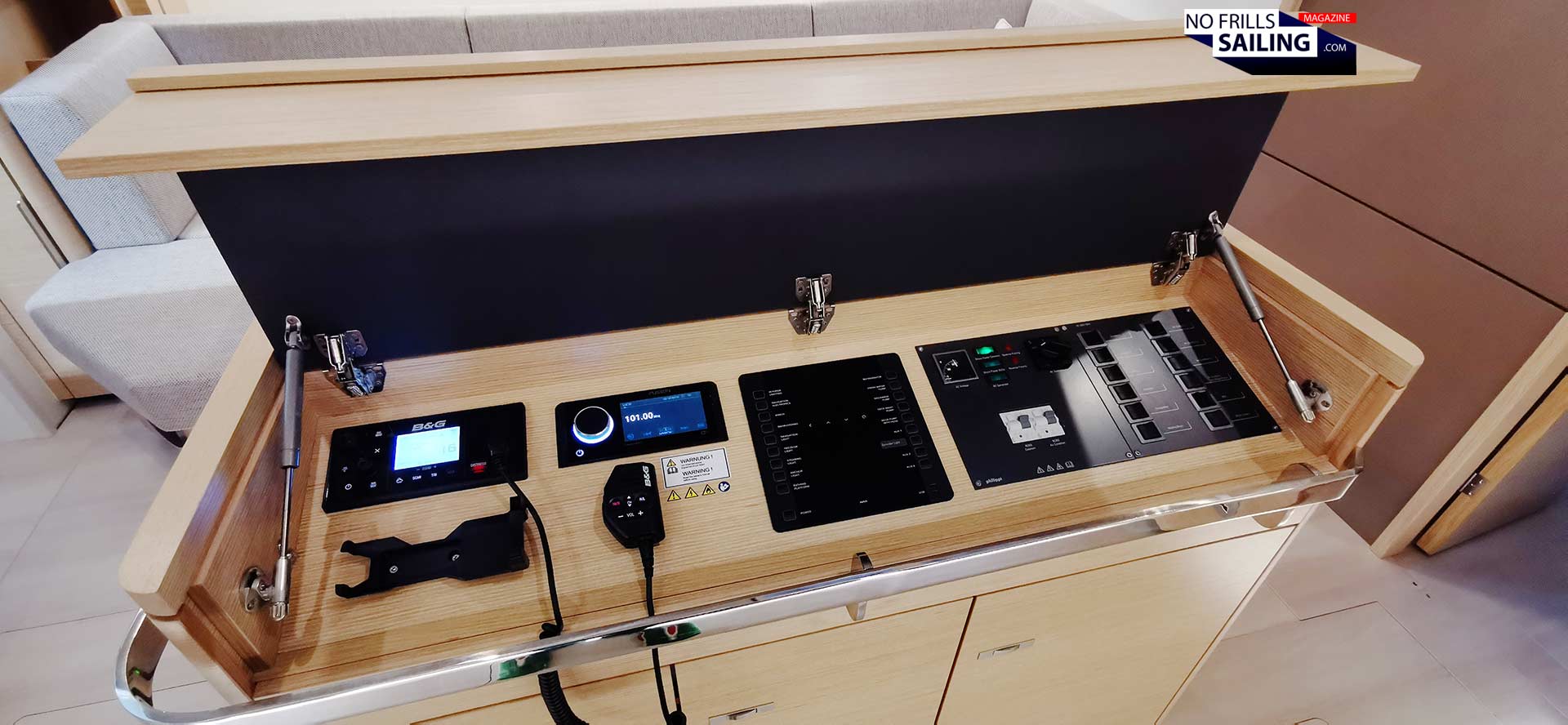
We will later discuss the multiple internal layouts and there is indeed one very classic owner-oriented layout where there is a full-fledged nav-station with all controls and panels to starboard side adjoining the – then shorter – galley. I´d say that the version with the central “electric hub” as shown is predominantly used in charter variants of the 510 or for strictly vocational coastal sailing, not for the long cruises or bluewater.

Looking at all of this, I notice the little nice details, like massive (and I mean massive!) wooden intarsia and wooden edges. I´ve seen the joinery of Hanse Yachts previously and hadn´t expected to see so many details made of massive wood. Especially here along the central aisle where most of the intra-ship-traffic will pass, those elements will make for a longer lasting furniture.
Classic family cruising
So, this central unit divides the saloon, as I mentioned before. To portside a classic U-shaped settee around a fairly big dining table is situated. Now that in current boats the central unit is a bit slimmer, this area will benefit from the extra space. I´d say that six people can sit there and have dinner easily, if needed, this could be widened to eight persons surely.
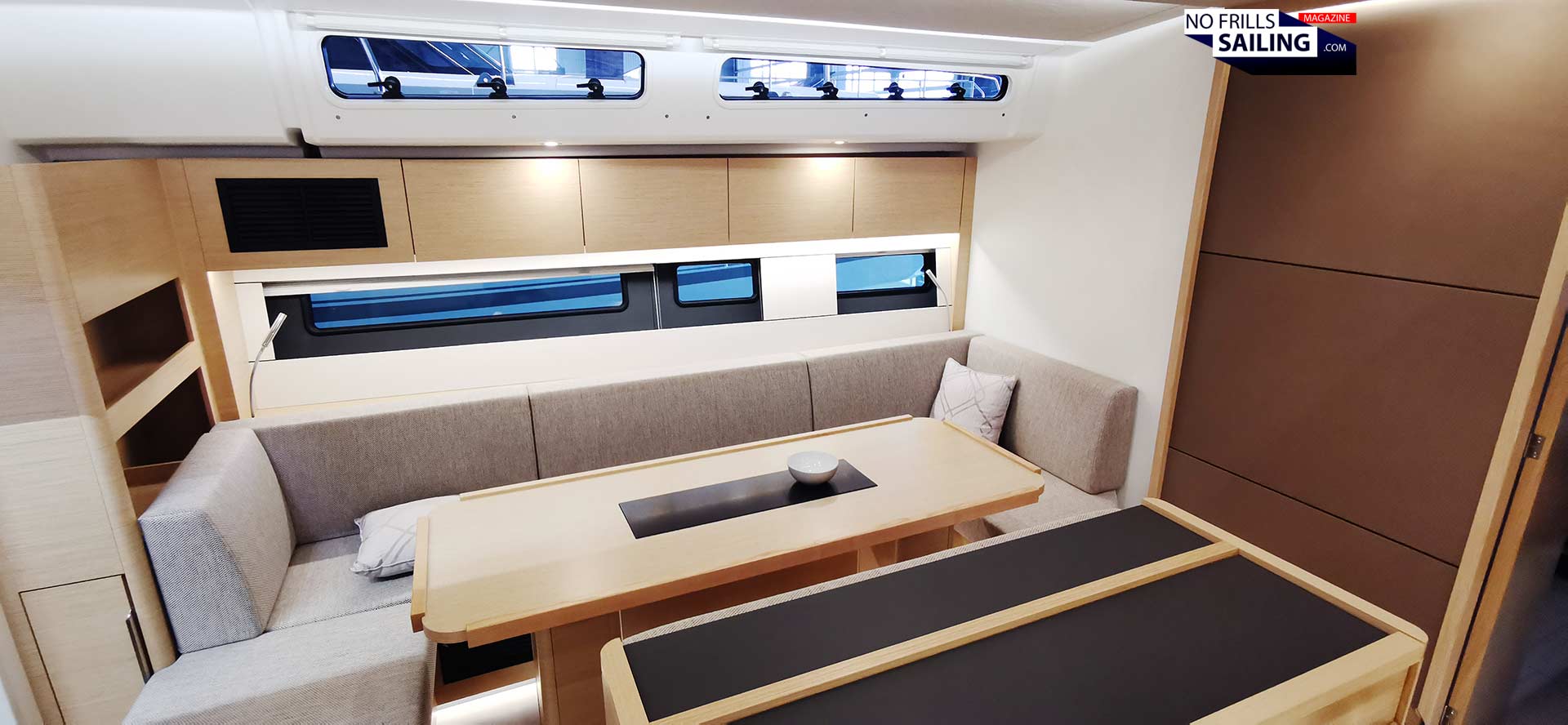
I don´t know but I guess that the dining table can be ordered to be adjustable for height. If this is the case and the table is lowered to the maximum, down here a fantastic lounge area will come into being. I still remember very vividly myself having to bunk in the salon during my first ever Atlantic Ocean offshore experience. I was seasick from Lisbon all the way to Madeira, four full days and nights, and the table was not capable of being lowered. You can imagine how often I fell from by bunk down to the floor in high seas … well, not so here.
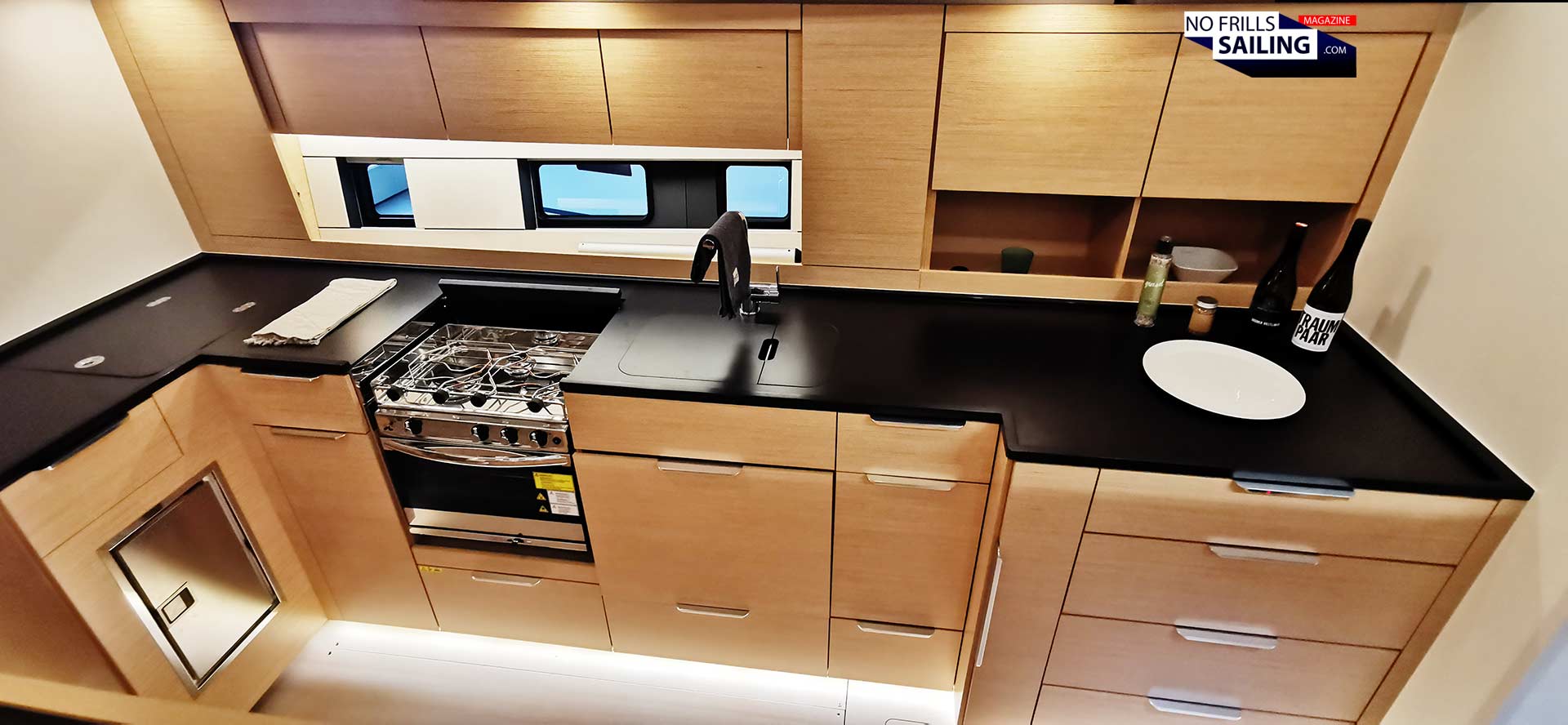
As for the galley, as a skilled NO FRILLS SAILING.com-reader you may know it, I don´t really fancy longitudinal galleys. I can see their advantages (predominantly the huge stowage capacity) but I just don´t like to look onto the dishes all the time! I would always prefer classic L-shaped galleys on their traditional locations to port side right next to the entryway. But on the Hanse 510, thanks to the central unit, it´s not that bad … at least, this big box blocks the view onto the unwashed dishes.

Another strong point for Hanse Yachts has always been the ventilation. All of the coachroof windows can be opened – and I mean the whole window, not just small portholes within the windows. There are also four large skylights which are openable, each one in a different direction so that a flow of fresh air can be maintained. A plus not only from this standpoint, but these windows together with the large hull-windows will make the saloon suffused with natural light.
Welcome to your loft!
As an owner of a 50-footer yacht you can expect a special area for you and your partner in the bow. The Hanse 510 is far from being the flagship model, but she as well offers some very lush luxury, especially for the owners. The front cabin is executed absolutely nicely! I like the modern take, the design, the contrasts and feel which reminded me (remotely) of the Elan E6. To portside the bathroom is located, vis-à-vis in the entrance area a small one-seater settee to get dressed/undressed.
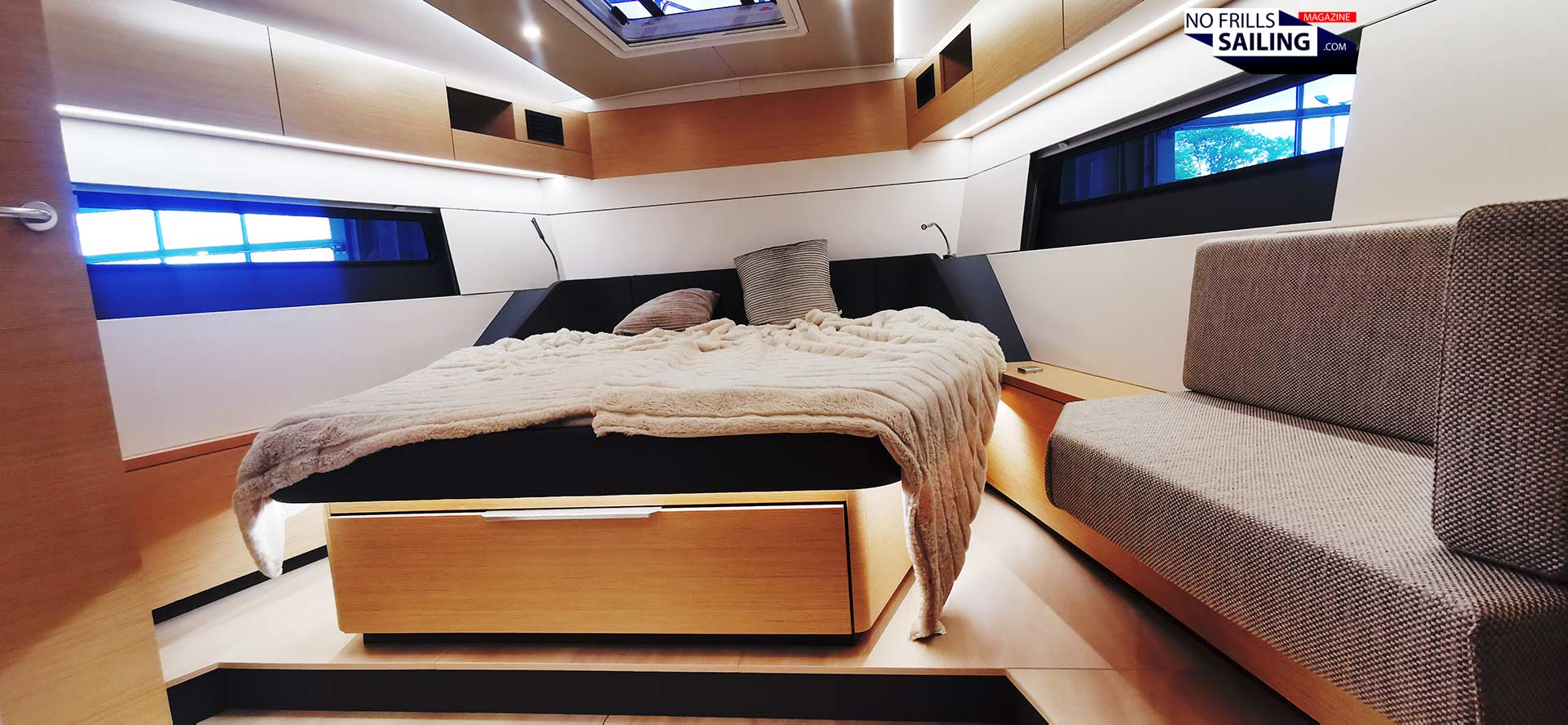
The island bed is raised on a kind of “stage”, large hull windows and one skylight as well as a nice “front window” (of which I sadly didn´t take a picture, sorry) provide lots of lateral light. Most certainly, a nice view when under sails or at anchor. I also detected nice stowage, overhead lockers and a huge receptacle underneath the bed. Although the furniture and panels are clearly made in “easy-to-fit” edgy modules, it doesn´t convey a cheap feel. I really like this bow cabin!
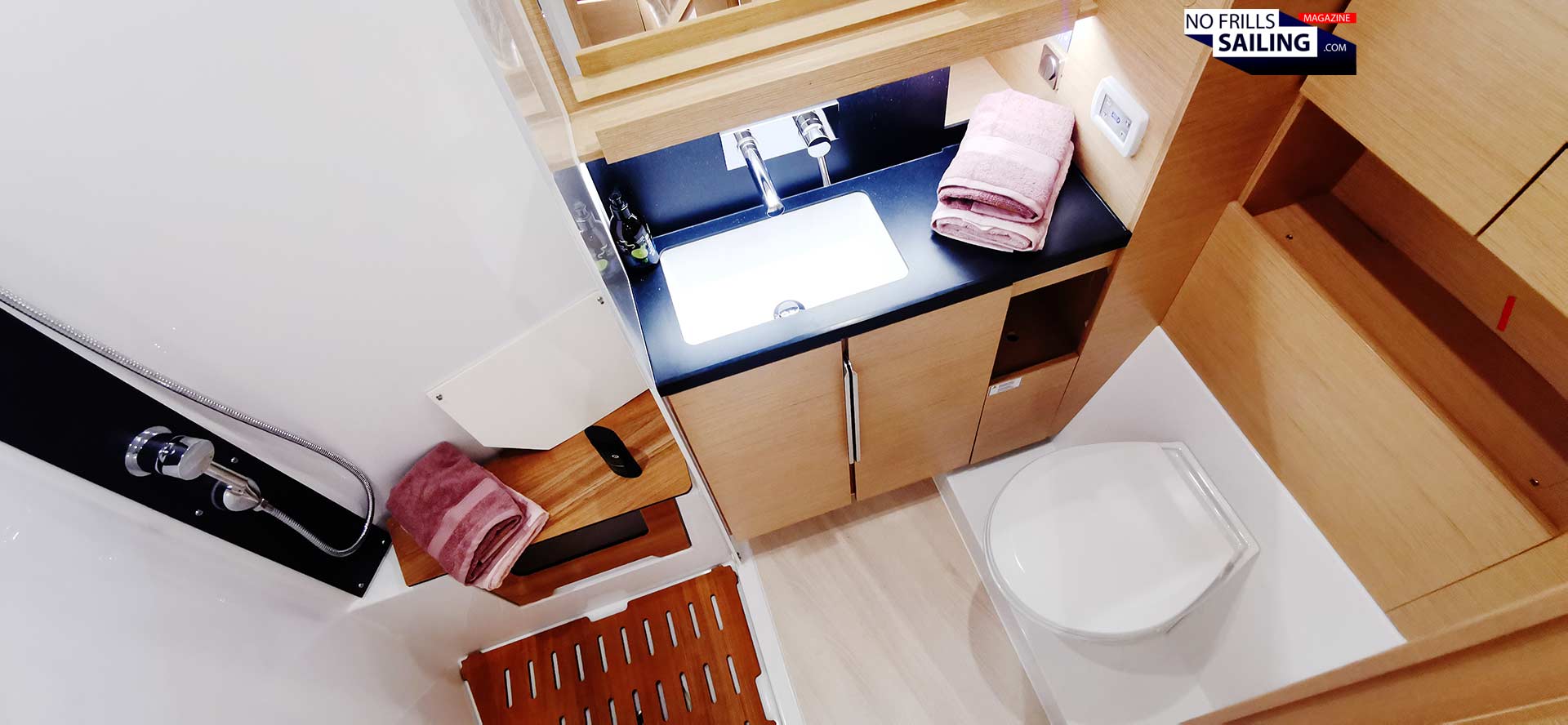
Owner´s bathroom along with the guest bathrooms are reasonably well sized. I personally would always prefer rather “cramped” bathrooms for multiple reasons. First and foremost, when underway, usually, the boat will sail through waves. This will make the hull move and especially when trying to pee or taking a dump what you do not need is free volume. You´d like to cuddle and wedge yourself in between the bulkheads to do your business in a safe and clean manner. What´s that fuzz with big bathrooms on yachts? Unsafe, wasted volume.
Versatile Layouts
Which brings us to the layout possibilities this boat brings. As being one of the “Big 5” production boat companies, Hanse Yachts has a wide range of target groups to sell their products too. The buyers range from serious offshore sailing world travelling couples over vacational family sailing to hardcore charter business. The shipyard needs concepts to satisfy all of them – and they found a nice set-up of layouts to do so. The Hanse 510 offers no less than 5 layouts.
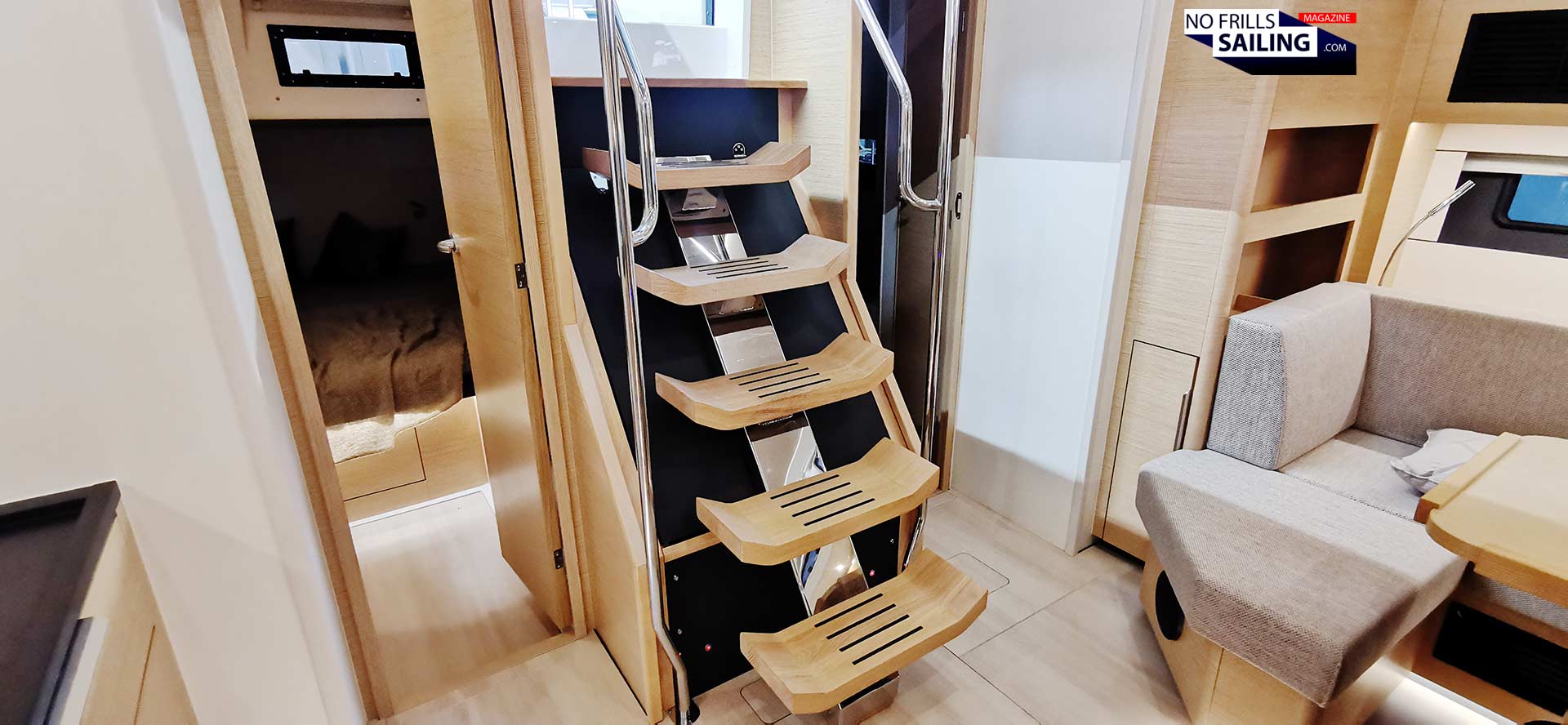
That´s the classy three-cabin, two bathrooms owner´s version up to the maximum of four cabins, four bathrooms and even five (!) cabins, two bathroom charter versions. In between, you may choose from two or three to four bathrooms, a pulman cabin, a wet cloth locker/household-appliances/utilities room or the before mentioned classic nav-station with a dedicated chart table. The iterations are manifold and I am sure there is one Hanse 510 for any need possible to combine and put together.
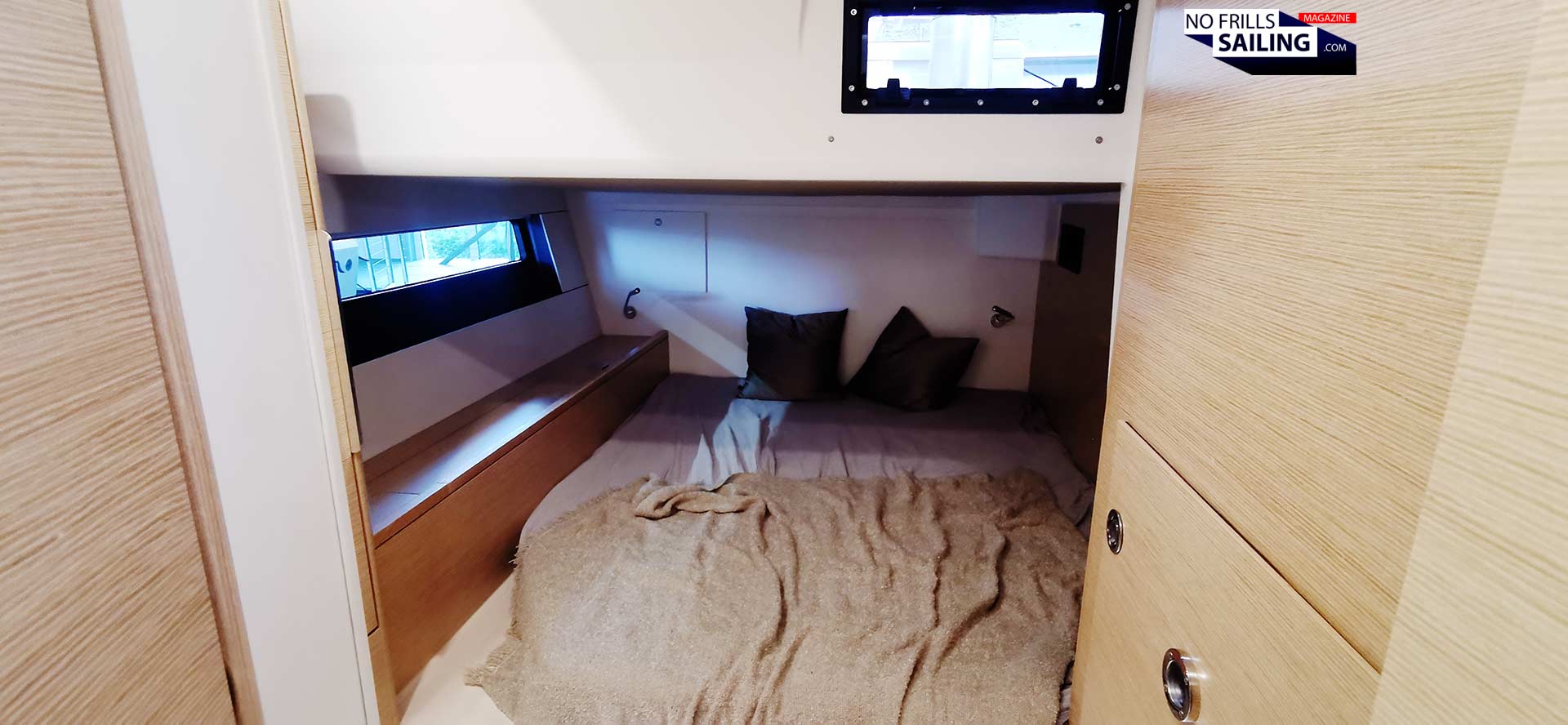
As for the aft cabins (sorry for not switching on the lights here before taking the picture), they are decently sized, all come with a nice large hull window, which, from my point of view should be a standard thing in modern pleasure yachts now, and two opening portholes minimum for ventilation. As the design of the cockpit area above is very homogenous, the ceiling is just a ceiling – I don´t like looking at the backside of cockpit lockers from underneath in so many other boats. It´s nicely done on the Hanse 510.
A boat worth looking at
So, in the end, what is she like, this Hanse 510? As I said, she is definitely a modern boat with a partially aggressive look. She carries the distinct Hanse-signature lines but also comes with a set of very own design features, like the inverted bow. As a sailing yacht made for pleasure cruising, this 50-footer should be a serious consideration of you if you consider investing in your next yacht. Hanse is known for very good sailing capabilities and I am sure that the 510 is no exemption from that.
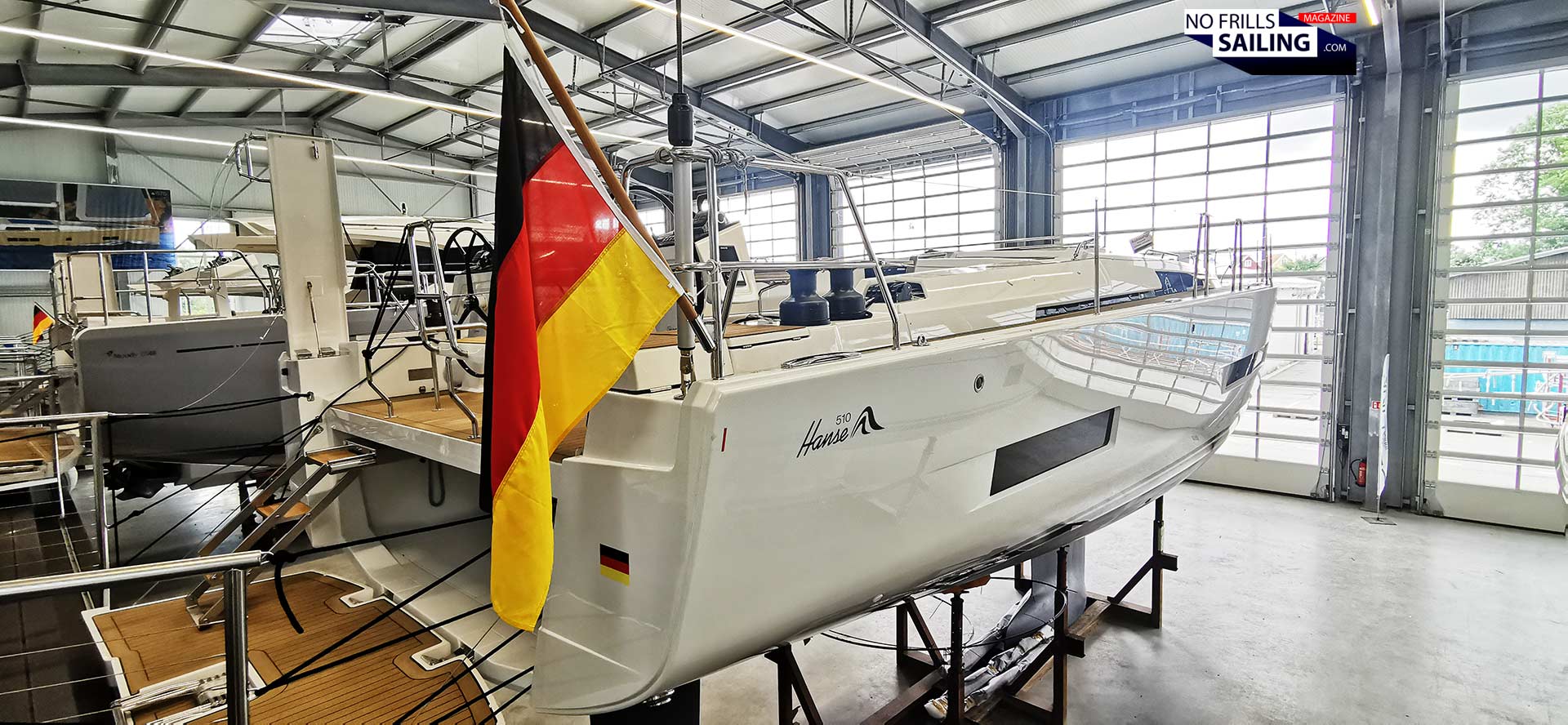
She is a boat worth looking at: Certainly because of her very German features but now even more because there are so many French aspects incorporated that I am sure you will be equally surprised when taking your time to roam that boat. Thanks Maxim for spending another hour aboard that boat with me, taken off of your precious time!
You might as well like to read these related articles:
The “Paukenschlag”-Boot: Hanse´s new 460
The new 410: Walkthrough during Boot Duesseldorf
At the Hanse Yachts shipyard in Greifswald/Germany
